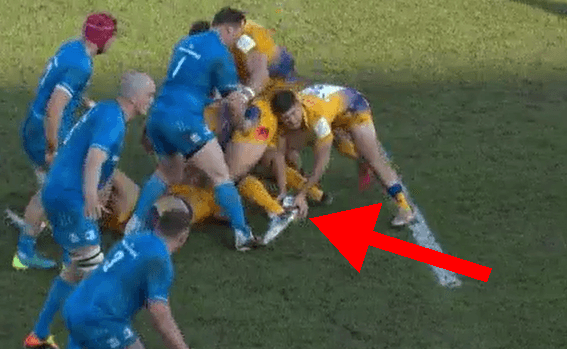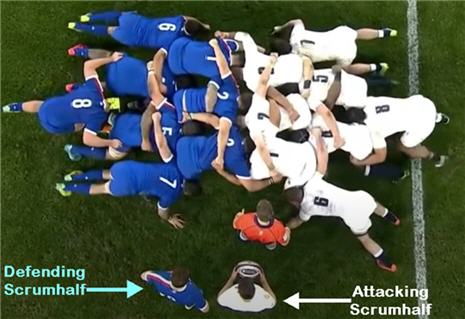Rugby Union and Rugby League are two sports played with an egg-shaped ball. To the average observer, one rugby match probably looks like the other.
But there are major differences between the codes. Here are my top nine!
Number Of Players
In Rugby Union 15 players are on the field at any given time. Each side (team), has another 8 players they can use for substitutions as well throughout the game.
Rugby League, on the other hand, only has 13 players per team on the field. But 10 additional players can be used as substitutes.
If you want the reasons behind the different numbers in the fifteens version, check out our detailed article on how many players are on a rugby team.
Possession Of The Ball
Possession in Rugby Union lasts for as long as a side holds onto the ball legally.
It doesn’t matter how many tackles are made.
You can read more in our article on how many phases can happen in Rugby Union. It describes some famous international matches with a whopping number of phases.
In contrast, Rugby League limits possession to six tackles. After that, the possession has to switch to the opposing team.
When A Player Is Tackled
If a Rugby Union player is tackled he has to release the ball on the ground when taken down.
That doesn’t mean he can’t pass it while going down or being hit. However, once on the ground, he cannot keep holding onto the ball.
His teammates can form a physical barrier around the ball to stop an easy grab by the opposite team.
We’ve highlighted the ball in this screenshot. Notice how the players in yellow are preventing the players in blue getting at the ball.

This is allowed, but the tackled player must not take any action to prevent the opposition players from going for the ball. It can be a bit painful being under all those cleats too.
In Rugby League each team basically keeps the ball until six tackles occur or they lose the ball by accident, losing grip during a tackle. After that, the ball goes to the other team.
When The Ball Goes Out Of Play
Rugby Union has a very specific and detailed approach to what happens when the ball goes over the sidelines. In this scenario, the ball is thrown back into play by one side.
Dubbed a “lineout,” the two teams form lines of players from the edge of the field inward. The team with possession then gets to throw the ball to a player lifted high by his teammates to catch it.

The opposing team can also jump to block or intercept the throw. Once the ball is in, it gets passed and the game moves on.
In Rugby League, a ball out of touch generally requires a scrum to restart the game. There are no lineouts in Rugby League.
The Scrum
In Rugby Union, the scrum is a very formal, rule-driven scenario.
The scrum starts with the forwards of each team interlocked and the two front rows pressing against each other.
The ball is then rolled in by the team in possession via the scrumhalf, who then has seconds to pass the ball out to the backs.

Rugby Union scrums occur from several infringements, including offsides and forward passes. The referee will also call for a scrum if he stops play due to major injuries (particularly blows to the head).
By the way, have you ever wondered why Union forwards seem to be chanting as they pack down? Check out our articles on what players say in the scrum.
Scrums in rugby league
Rugby League has scrums, but only half the number of players are involved. League scrums are more about forwards holding their position than an actual effort to take control of the ball.
The ball is rolled between the sides and comes out of the scrum to be passed to the outside players.
A scrum takes place in Rugby League when the ball is:
- knocked forward
- goes out of bounds
- is passed forward illegally
A scrum is also awarded when there is a clear play violation and penalty.
Size Of The Field
Both sports allow for a range of acceptable pitch sizes.
The width of the field is about the same for the two sports. It usually measures close to 70 meters.
A Rugby Union field ranges from 106 meters to 144 meters. A League field ranges from 112 to 122 meters.
However, there are very few Union pitches that are as short as 106 meters. The examples I know are older clubs in towns and cities. In general, a Rugby Union field is longer than a League field.
The Shape Of The Ball
The Rugby Union ball is a large egg-shaped unit that seems kind of squat and stubby on both sides.
This gives plenty of room for handling as well as kicking spot on, but it still has some aerodynamic shape to move when passed through the air correctly.
The Rugby League ball looks like the Union version on a diet. It’s longer from end to end and slimmer. The sleek design is notably faster in passing but harder to kick with accuracy.
Scoring Systems
You score points in both sports through tries, conversions, penalty kicks, and drop goals. However, the points awarded are different across the sports.
| Union | League | |
| Try | 5 | 4 |
| Conversion | 2 | 2 |
| Penalty Kick | 3 | 2 |
| Drop Goal | 3 | 1 * |
| Penalty Try | 7 | Potentially 8 |
The drop goal may be changing in League from a single point. Australia is bringing in a two-point score.
A penalty try is awarded when the referee decides that an infringement prevented a certain try from being scored.
In Rugby Union, seven points are awarded straight away for a penalty try. The conversion isn’t required (this is a relatively recent change).
Why is a penalty try worth eight points in rugby league?
In Rugby League, the penalty try gives four immediate points.
The extra two points for the conversion are then awarded.
And finally, the team in possession is also awarded a penalty kick from the place of the infringement. If the placekicker is successful, the team has a total of 8 points.
Ball In Play
Several studies have been done to measure the amount of time that the ball is “in play” in rugby.
Recent figures for Rugby Union show that the ball is in play for about 36 minutes.
Recent figures for Rugby League show that the ball is in play for about 55 minutes.